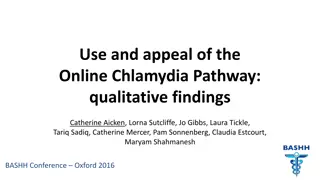Pathway to Hope: Transforming Mental Health and Addictions Care in British Columbia
"A roadmap for improving mental health and addictions care in BC, addressing system fragmentation, lack of access, stigma, and rising demands. Strategy development involves review, consultation, and collaboration, leading to a ten-year vision focused on prevention, early intervention, and societal action. A three-year action plan emphasizes wellness for children, youth, and young adults, supporting Indigenous-led solutions and enhancing access to quality care."
Download Presentation

Please find below an Image/Link to download the presentation.
The content on the website is provided AS IS for your information and personal use only. It may not be sold, licensed, or shared on other websites without obtaining consent from the author. Download presentation by click this link. If you encounter any issues during the download, it is possible that the publisher has removed the file from their server.
E N D
Presentation Transcript
Pathway to Hope: A roadmap for making mental health and addictions care better for people in BC Child and Youth Mental Health and Substance Use Community of Practice March 6, 2020
Our Starting Point System System Fragmentation, poor transitions, difficult navigation Lack of equitable access to culturally safe and non- discriminatory care Very little focus and investment upstream Stigma and affordability Increasing demand outpacing capacity People People Mental health and substance use challenges affect 1 in 5 1,510 deaths due to overdose in 2018 Highest rate in Canada of hospitalization due to mental illness and substance use disorder 2
Strategy Development Review of reports and recommendations over recent years, current state analysis and jurisdictional scans Consultation process with people with lived experience, service providers, and community advocates Collaborative and integrated cross ministry and Indigenous partner policy development Expert advisory committees 3
A Pathway to Hope Ten year vision Ten year vision with the roadmap that sets a long term direction for a new system of care Supported by a series of actions over three years three years, organized into four areas of focus to get us started actions over Emphasis on prevention, promotion prevention, promotion and early intervention and early intervention Setting the direction and a call to action for all of society action for all of society call to Building on existing implementing new approaches existing initiatives and new, innovative 4
Three Year Action Plan: 2019/20 2021/22 Improved Wellness for Children, Youth and Young Adults Supporting Indigenous-led Solutions Improved Access, Better Quality Substance Use: Better Care, Saving lives 6
Improving Wellness for Children, Youth & Young Adults Focus on Promotion/Prevention Focus on Promotion/Prevention Stronger Integration Stronger Integration Foundry expansion Perinatal services Step Up/Down supports Child development services Integrated Child and Youth Teams Social and emotional development tools Mental Health in Schools 7
ICY Teams - Aims Create a substantial shift in service delivery substantial shift in service delivery by using multidisciplinary teams and a family and child-centred approach. Eliminate the need for young people and families to navigate multiple services Eliminate the need for young people and families to navigate multiple services and retell their story with every interaction. Provide wrap around care based on one shared common plan for each child one shared common plan for each child. Integrated Child and Youth Teams Integrated Child and Youth Teams comprised of Education Counsellors, mental health practitioners, substance use workers, and other professionals (Indigenous and Parent/Youth Peer Support Workers) to support children, youth and their families. Multidisciplinary Teams Multidisciplinary Teams provide outbound services common plan common plan. Teams are linked to specific schools and connect children and youth to other services and supports as needed. outbound services and collaboratively develop linked to specific schools, adjust service intensity as needed Pathways between ICY Teams and Primary Care, specialized and high intensity services and early years services. 8
Current State Future State MH Care MH Care Community Supports Creation of Structures SU Care SU Care Children, Youth and Families Children, Youth and Families Change in Practice Education Support Education Support Indigenous Support Community Supports Peer Support 9
ICY Teams Model Wraparound MHSU care for all children and youth under 19. Five school districts (first teams: Maple Ridge-Pitt Meadows, Comox Valley). Outbound care, meeting youth and families where they are comfortable. Multidisciplinary Each ICY Team will be connected to a family of elementary, middle, and secondary schools. Practice principles include cultural safety and humility, trauma-informed practice, youth/family centred care. Adaptable to build on existing local service delivery strengths, and respond to unique circumstances. 10
ICY Teams Team Composition Child/Youth-Specific Team Members Core Team Members To vary based on the unique strengths, needs and preferences of the child/youth, family/caregiver, and school/community. Permanent teams, to include children, youth, families/ caregivers Social workers Nurses Occupational Therapists Speech/language pathologists Youth workers Youth probation officers Caring adults/allies of children and youth Primary care physicians, nurse practitioners, pediatricians Psychologists, Psychiatrists Behavioural consultants/ mentors Case Coordinator CYMH Clinicians Youth Substance Use Workers Education Counsellors Elders, Traditional Healers and Indigenous support workers Youth and family peer support workers with lived experience Functional Linkages Engaged as-needed to ensure wraparound care Primary Care Networks Early Years Services Foundry (where available) Specialized MHSU Services (hospital, residential, etc.) 11
Foundry Youth Centres Original prototype developed at Vancouver Granville Youth Centre 2015, rebranded in 2017. Funding to support expansion to 6, then 11 centres in 2016 and 2017 Today: 8 centres open, 3 in development Defined integrated stepped care model Over 140 partners involved Sustainable core centre and FCO funding Government commitment to expand to 19 centres Commitment to increase cultural safety and humility in centres 12 ADM Foundry Briefing July 19, 2019 DRAFT FOR DISCUSSION
Key Enablers and Supports Performance monitoring, evaluation and reporting Performance monitoring, evaluation and reporting on the impact of the initiatives in the Roadmap Continued cross cross- -sector integrated sector integrated policy, planning, and implementation for improved system coordination and outcomes Cross-sector workforce planning workforce planning Effective governance and accountability
Questions? 14























